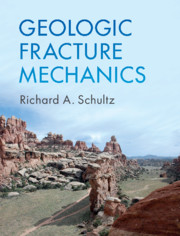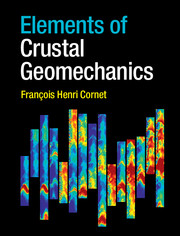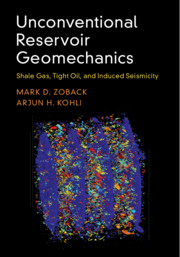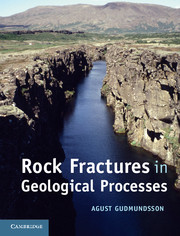Geologic Fracture Mechanics
£69.99
- Author: Richard A. Schultz, Orion Geomechanics LLC
- Date Published: August 2019
- availability: In stock
- format: Hardback
- isbn: 9781107189997
£
69.99
Hardback
Other available formats:
eBook
Looking for an inspection copy?
This title is not currently available on inspection
-
This lively introduction to geologic fracture mechanics provides a consistent treatment of all common geologic structural discontinuities. It explores the formation, growth and interpretation of fractures and deformation bands, from theoretical, field and lab-based perspectives, bridging the gap between a general textbook treatment and the more advanced research literature. It allows the reader to acquire basic tools to interpret discontinuity origins, geometries, patterns and implications using many of the leading and contemporary concepts known to specialists in the field. Problem sets are provided at the end of each chapter, and worked examples are included within each chapter to illustrate topics and enable self-study. With all common geologic structures including joints, hydrofractures, faults, stylolites and deformation bands being discussed from a fresh perspective, it will be a useful reference for advanced students, researchers and industry practitioners interested in structural geology, neotectonics, rock mechanics, planetary geology, and reservoir geomechanics.
Read more- Covers all the major and important types of geologic structural discontinuities in one place, providing a synoptic, unified treatment of the major structures
- Introduces readers to fracture mechanics with applications to rock, highlighting how geologic structural discontinuities form, grow and interact from a fresh mechanics perspective
- Discusses current hot topics such as displacement-length scaling and non-linear elastic fracture mechanics
Reviews & endorsements
'This timely volume bridges textbook and research literature and should be consulted by any geologist or engineer who must deal with discontinuous geological media, whether in soils or rocks. Casual readers might think it relevant only to the contemporary issue of shale fracking, but anyone dealing with foundations, roads, and the like will find this book useful. While theoretical aspects are covered, the book mainly deals with field occurrences of fracture (providing photographic illustrations of particular types) and their interpretation … Exercises and solutions accompany each chapter, in addition to 'learning maps' depicting the concepts covered and their relationships.' M. S. Field, Choice
Customer reviews
Not yet reviewed
Be the first to review
Review was not posted due to profanity
×Product details
- Date Published: August 2019
- format: Hardback
- isbn: 9781107189997
- length: 608 pages
- dimensions: 253 x 193 x 31 mm
- weight: 1.46kg
- contains: 294 b/w illus. 23 tables
- availability: In stock
Table of Contents
Preface
1. Introduction to geologic structural discontinuities
2. Elastic rock rheology and stress concentration
3. Stress, Mohr circles, and deformation at peak strength
4. Cracks and anticracks
5. Discontinuity patterns and their interpretation
6. Faults
7. Deformation bands
8. Fracture mechanics: a tour of basic principles
9. Beyond linear elastic fracture mechanics
Answers to selected exercises
Glossary
References
Index.-
Find resources associated with this title
Type Name Unlocked * Format Size Showing of
This title is supported by one or more locked resources. Access to locked resources is granted exclusively by Cambridge University Press to lecturers whose faculty status has been verified. To gain access to locked resources, lecturers should sign in to or register for a Cambridge user account.
Please use locked resources responsibly and exercise your professional discretion when choosing how you share these materials with your students. Other lecturers may wish to use locked resources for assessment purposes and their usefulness is undermined when the source files (for example, solution manuals or test banks) are shared online or via social networks.
Supplementary resources are subject to copyright. Lecturers are permitted to view, print or download these resources for use in their teaching, but may not change them or use them for commercial gain.
If you are having problems accessing these resources please contact [email protected].
Sorry, this resource is locked
Please register or sign in to request access. If you are having problems accessing these resources please email [email protected]
Register Sign in» Proceed
You are now leaving the Cambridge University Press website. Your eBook purchase and download will be completed by our partner www.ebooks.com. Please see the permission section of the www.ebooks.com catalogue page for details of the print & copy limits on our eBooks.
Continue ×Are you sure you want to delete your account?
This cannot be undone.
Thank you for your feedback which will help us improve our service.
If you requested a response, we will make sure to get back to you shortly.
×





